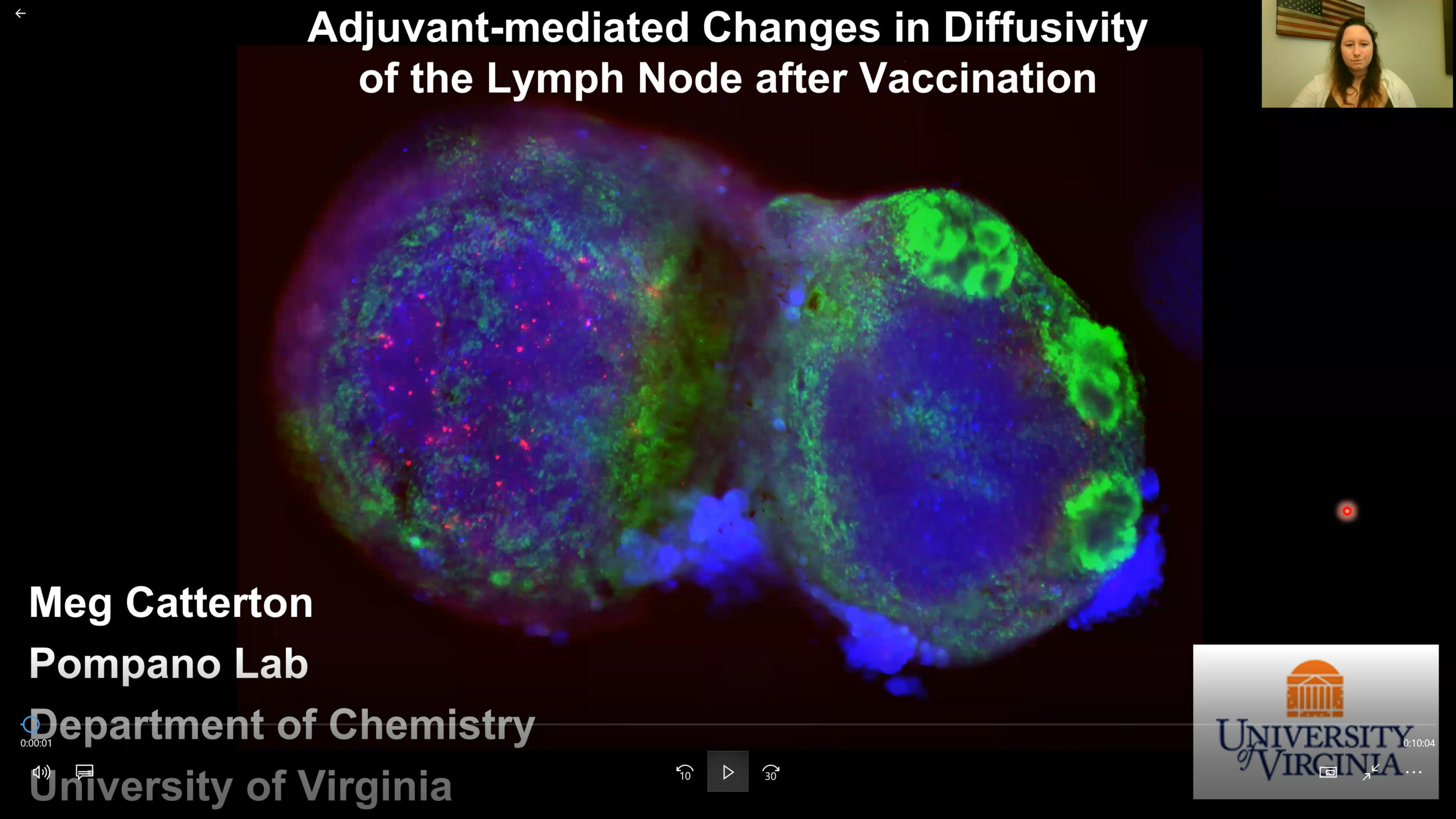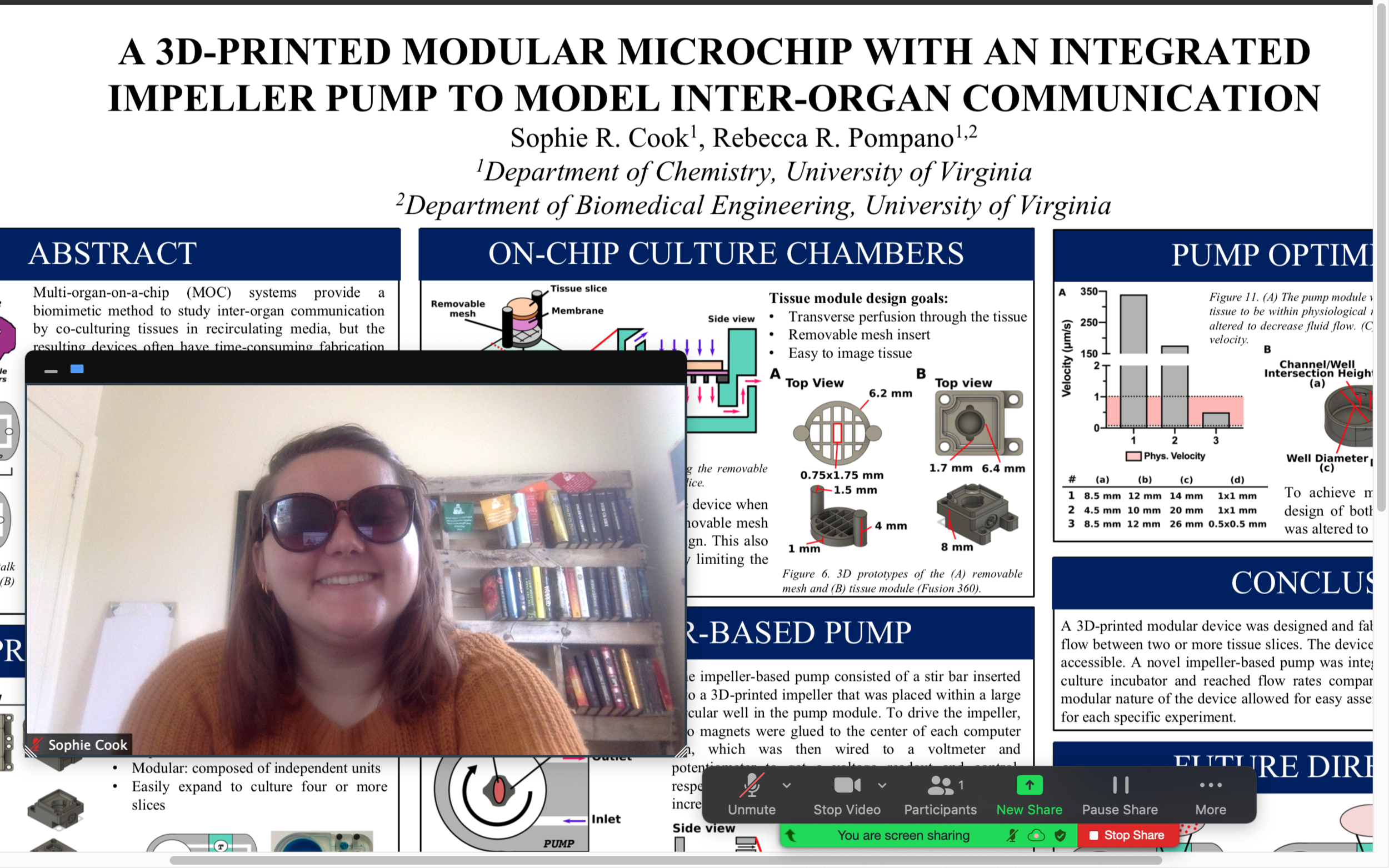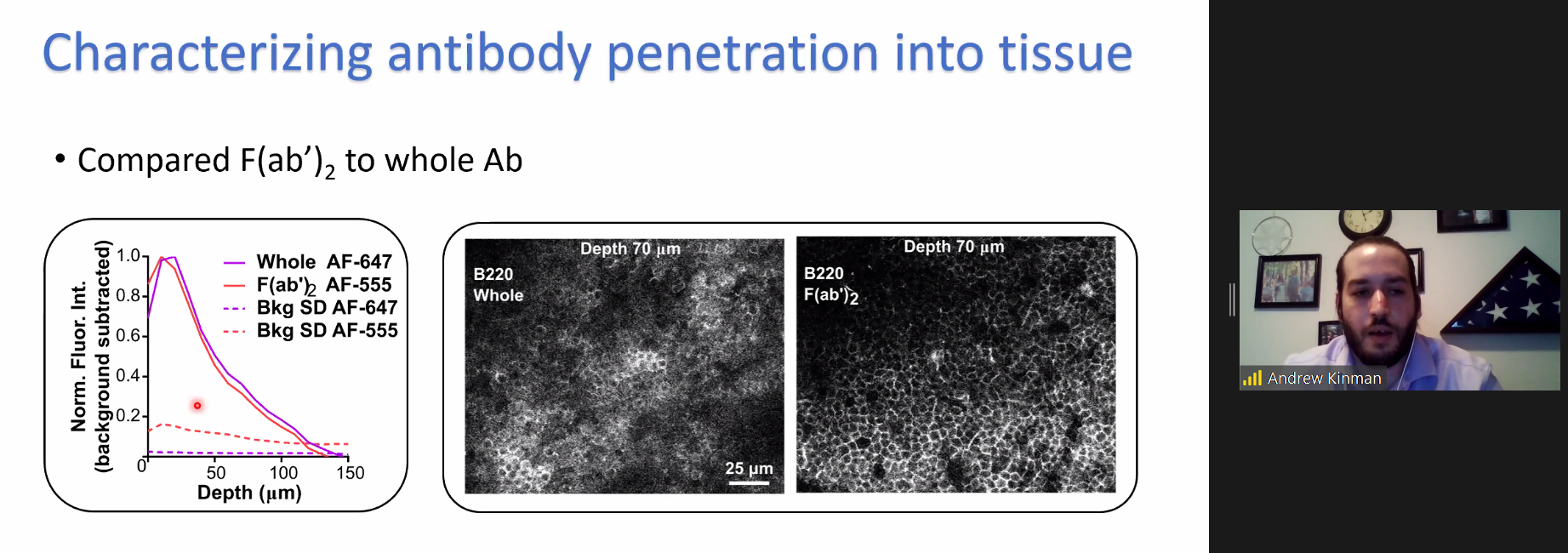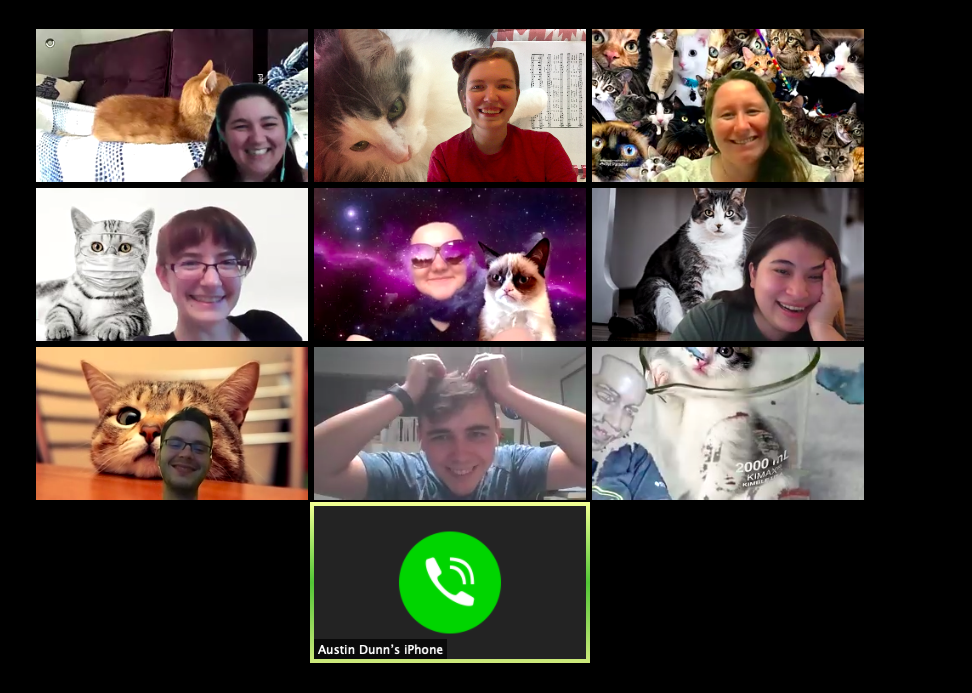We heartily congratulate Sophie, who was awarded a Spring 2021 research grant from the Graduate School of Arts and Sciences Council. These are competitive awards and an honor to receive. She wrote a compelling proposal to further her development of a miniaturized recirculating pump with a brand new 3D printer that is safe to use from home during the ongoing pandemic, plus parts for a new type of motor. Excellent work, Sophie!
Hannah enters PhD candidacy!
Congratulations to 2nd year student Hannah Musgrove, who earned a Pass on the PhD candidacy exam this month. She is now officially a PhD candidate. We look forward to seeing her research develop in the area of 3D printed microchips and hybrid tissue-chips. Congrats Hannah!
Prof. Pompano contributes to article on active learning in remote courses
Prof. Pompano co-authored a paper with Prof. and Chair Jill Venton on how active learning helps engage students during remote courses. The article includes many tips and lessons learned from Prof. Pompano’s Analytical courses, which were offered remotely in 2020 due to the COVID-19 pandemic.
The article is part of a series organized by Analytical Bioanalytical Chemistry on teaching during the pandemic. We hope that it is helpful!
Two new papers on lymph node slices
Two papers were published from our lab in late 2020 and early 2021, establishing the methods and possibilities of using murine lymph node slices to study short-term adaptive immune responses.
Congratulations to Maura Belanger et al, for completing and publishing many years of work in ACS Pharmacology & Translational Science, 2021.
This work establishes our best practices for collection of murine lymph node slices, demonstrates a lack of overt inflammation from the process of slicing, and characterizes their ability to respond to direct and indirect T cell stimulation. Finally, it provides some of the first evidence that lymph node slices from vaccinated animals can response to antigen ex vivo. We look forward to continuing to share this platform with other researchers.
Congratulations to Alex Ball et al, who recently solved a longstanding bottleneck in our lab. We found that lymph nodes from vaccinated animals were the most difficult to slice, because did often failed to adhere to the supporting agarose hydrogel. Alex worked out a simple method to solve this problem, via a quick dip in a gentle detergent solution. We share this technical advance in the Journal of Immunological Methods, 2021.
Congratulations to Maura, Alex, and the entire team!
Dr. Pompano presents keynote at MRS symposium
MRS 2020: On December 2, 2020, Dr. Pompano presented one of two live keynote talks in the symposium, “Biomaterials for Studying and Controlling the Immune System,” organized by Evan Scott, Kara Spiller, Eric Appel, and Derfogail Delcassian. The talk was followed by a thought-provoking panel discussion on the role of biomaterials in directing immunity, particularly for COVID-19 vaccination and against autoimmune diseases, with Joel Collier, Ben Keselowsky, Lonnie Shea, Ankur Singh, and Chris Jewell.
Welcome new group members
Despite the pandemic slow down, the Pompano Lab was able to welcome three new group members this fall! We are delighted to work with each of these talented scientists and to see them take charge of new research directions.
Amirus Saleheen, PhD
Postdoctoral Scholar
Dr. Saleheen joined the lab in August, 2020. He obtained his BS in Applied Chemistry and Chemical Engineering at the Univ. of Dhaka, Bagladesh, and his PhD in Chemistry at the University of Tennessee, Knoxville. His graduate work consisted of developing a novel microfluidic chip to mimic rotary tube culture of rodent brain slices, to improve the temporal resolution of downstream perfusate analysis. He also developed a smartphone based quantitative analysis method for epinephrine in expired or discolored auto-injectors, to help those old EpiPens stay usable. In the Pompano lab, Amirus will be working on robust fluidic control methods and stimulation of a lymph-node-on-a-chip model.
Dr. Ozulumba joined the lab in October, 2020. She obtained her BS and MS degrees in Biochemistry at the Univ. of Nigeria, and then completed a PhD in Biomaterials Science at the Univ. of Brighton, United Kingdom. Her PhD project investigated the potential of two-dimensional graphene and titanium carbide MXene nanomaterials to target biological toxins and the incorporation of these materials into composite systems for use in medical devices. In the Pompano lab, Tochukwu will be working on controlling immune cell interactions with biomaterial in a spatially organized microphysiological model of a lymph node.
Tochukwu Ozulumba, PhD
Postdoctoral Scholar
Lavoisier Akoolo, PhD, DVM
Immunology Research Scientist
Dr. Akoolo joined the lab in October, 2020. He graduated with a DVM and MS from the Univ. of Nairobi in Nairobi, Kenya, and worked as a Veterinarian in the Ministry of Livestock, Kenya, before moving to Texas A&M University in College Station, Texas, where he graduated with a PhD in Veterinary Pathology in 2015. Lavoisier completed postdoctoral training in microbial pathogenesis at Rutgers New Jersey Medical School, leading to several publication in microbiology and immunology. In the Pompano lab, he will be expanding the use of live slices of lymph node tissue as an ex vivo model of immunity.
New paper: Mapping glucose uptake in live tissues
Our newest paper is out in Analytica Chimica Acta. Austin Dunn and Meg Catterton established a robust, optimized protocol to image glucose uptake in living tissues ex vivo. You can see heterogeneity across the tissue, and changes over time! We tested it in lymph node slices and were able to detect the response to T cell stimulation. Congrats Austin and Meg for this very useful work!
Austin F. Dunn, Megan A. Catterton, Drake D. Dixon(#), and Rebecca R. Pompano. “Spatially resolved measurement of dynamic glucose uptake in live ex vivo tissues.” Analytica Chimica Acta (2020). Online before print. [link].
Presentations at MicroTAS and BMES
The Pompano lab was out in force at the virtual MicroTAS 2020, with the majority of the group attending. PhD student Sophie Cook presented her poster on a modular micro-culture system with a novel media pump. Prof. Pompano presented in the pre-conference workshop on Organs-on-Chip, with a tutorial on incorporating tissue and immune functions into microphysiological systems. Plus she had fun as a poster judge!
The next week, PhD student Megan Catterton presented a virtual on-demand talk at virtual BMES 2020. She spoke on her and undergraduate Tim Freeman’s work measuring diffusion through inflamed lymph nodes.
Congrats to everyone for their involvement! We look forward to returning to these conferences in person next year.


Congrats Andrew Kinman, PhD, & Austin Dunn, MS
July was an eventful month for the Pompano lab, with two defenses and graduations!
First, Andrew Kinman successfully defended his dissertation and earned his PhD, then stayed a few more weeks to wrap up and pass on his projects to Pargat Singh. His excellent presentation was titled, “Modification and Application of Antibodies and Their Fragments for Immunostaining in Live Lymphatic Tissue Slices.”
Next, Austin Dunn defended his Master’s thesis and earned his MS degree! Look for his paper coming soon on his exciting project, “Spatially Resolved Measurement of Dynamic Glucose Uptake in Live Ex Vivo Tissues”.
Paper: Quantifying protein functionalization
New bioanalytical paper online last week! If you work with modified protein-based biomaterials, especially gelatin, this paper is for you. We describe optimized, validated methods to see just how modified it really is.
“Quantification of fractional and absolute functionalization of gelatin hydrogels by optimized ninhydrin assay and 1H NMR”
This work is extra special because it originated as a summer project for then brand-new graduate student, Jon Zatorski, and talented undergrad Alyssa Montalbine. They took the idea of improving the ninhydrin assay and ran with it. Jon pioneered the NMR work, the first to do so in our lab. (Thanks Jeff Elena in NMR core!)
Honored to have this work featured in Analytical and Bioanalytical Chemistry as part of the "Female Role Models in Analytical Chemistry" topical collection, alongside Jill Venton, Ashley Ross, and ~60 other inspiring women.



















